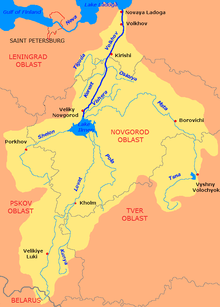Lovat River
Coordinates: 58°12′42″N 31°26′40″E / 58.21167°N 31.44444°E
| Lovat River | |
|---|---|
|
Lovat in Velikiye Luki | |
| Country | Belarus, Russia |
| Basin | |
| Main source | Lake Lovatets |
| River mouth | Lake Ilmen |
| Basin size | 21,900 square kilometres (8,500 sq mi)[1] |
| Physical characteristics | |
| Length | 530 kilometres (330 mi)[1] |
| Discharge |
|

The Lovat (Belarusian: Ловаць Lovać, pronounced [ˈɫovatsʲ]; Russian: река́ Ло́вать) is a river in Vitebsk Oblast of Belarus, Usvyatsky, Velikoluksky, and Loknyansky Districts, as well as of the city of Velikiye Luki, of Pskov Oblast and Kholmsky, Poddorsky, Starorussky, and Parfinsky Districts of Novgorod Oblast in Russia. The source of the Lovat is Lake Lovatets in northeastern Belarus, and the Lovat is a tributary of Lake Ilmen. Its main tributaries are the Loknya (left), the Kunya (right), the Polist (left), the Redya (left), and the Robya (right) Rivers. The towns of Velikiye Luki and Kholm, as well as the urban-type settlement of Parfino, are located on the banks of the Lovat.
From the source, the Lovat flows in the southeastern direction along the border between Russia and Belarus, the it turns north and enters Pskov Oblast of Russia, crossing the border as Lake Sesito. In this area, the Lowat flows through the lake district, passing, in particular, Lake Vorokhobskoye. Downstrean of Velikiye Luki, in the selo of Podberezye, the Lovat turns northwest and enters Novgorod Oblast. Close to Lake Ilmen, the Lovat shares a river delta with the Pola and the Polist, though technically Polist is counted as a tributary of the Lovat.
The river basin of the Lovat comprises vast areas in the south of Novgorod and Pskov Oblasts, as well as some areas in Tver Oblast and Vitebsk Oblast of Belarus.
The Lovat is listed in the State Water Register of Russia as navigable between Parfino and the mouth, however, there is no passenger navigation. Until the 1990s, it was used for timber rafting.[1]
The Lovat served as a stretch of the trade route from the Varangians to the Greeks, the most important trading route of medieval Rus. From Lake Ilmen, ships wen upstream the Lovat and then the Kunya, before ending up in the Western Dvina and the Dnieper, from where they could reach Constantinople via the Black Sea.[2]
References
External links
![]() Media related to Lovat River at Wikimedia Commons
Media related to Lovat River at Wikimedia Commons
- Река Ловать (in Russian). State Water Register of Russia. Retrieved 23 February 2012.